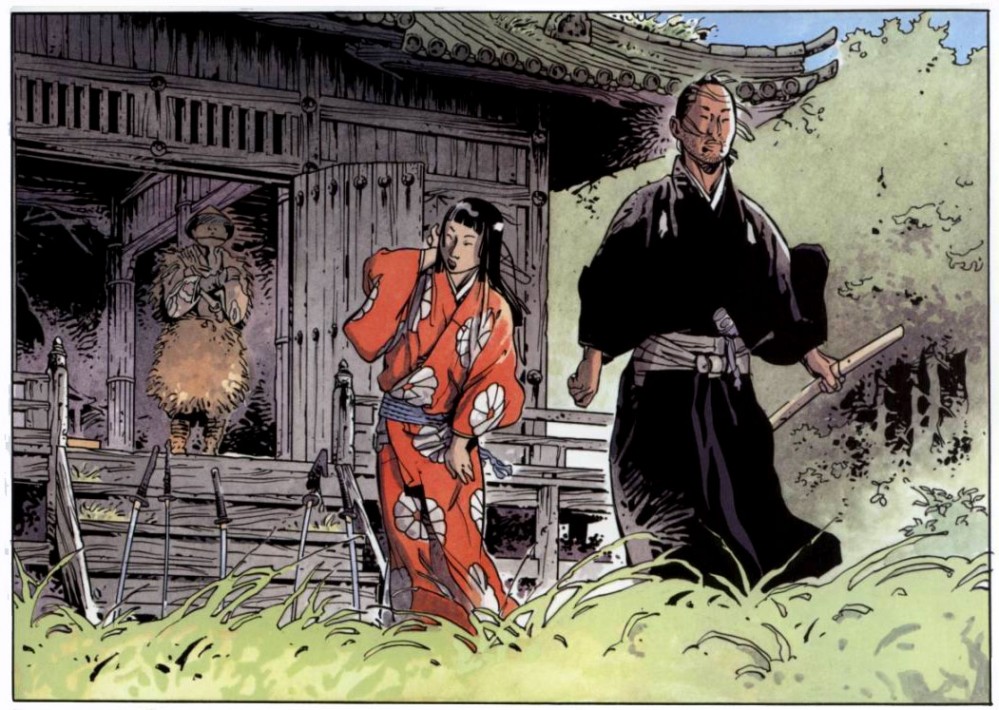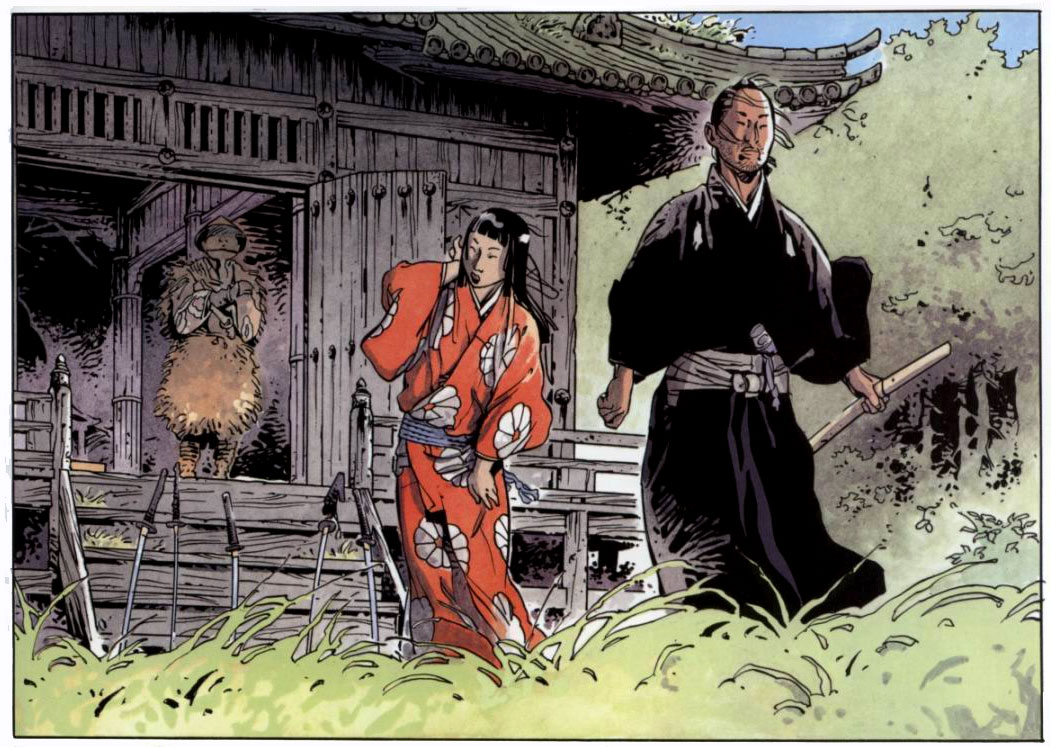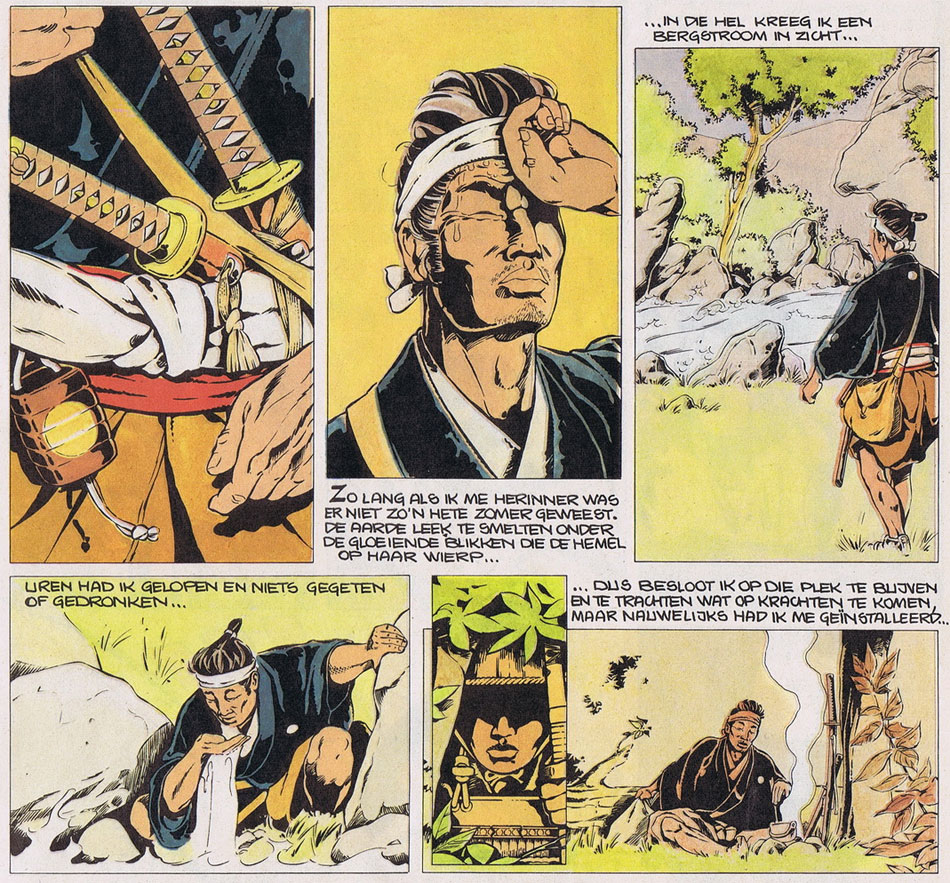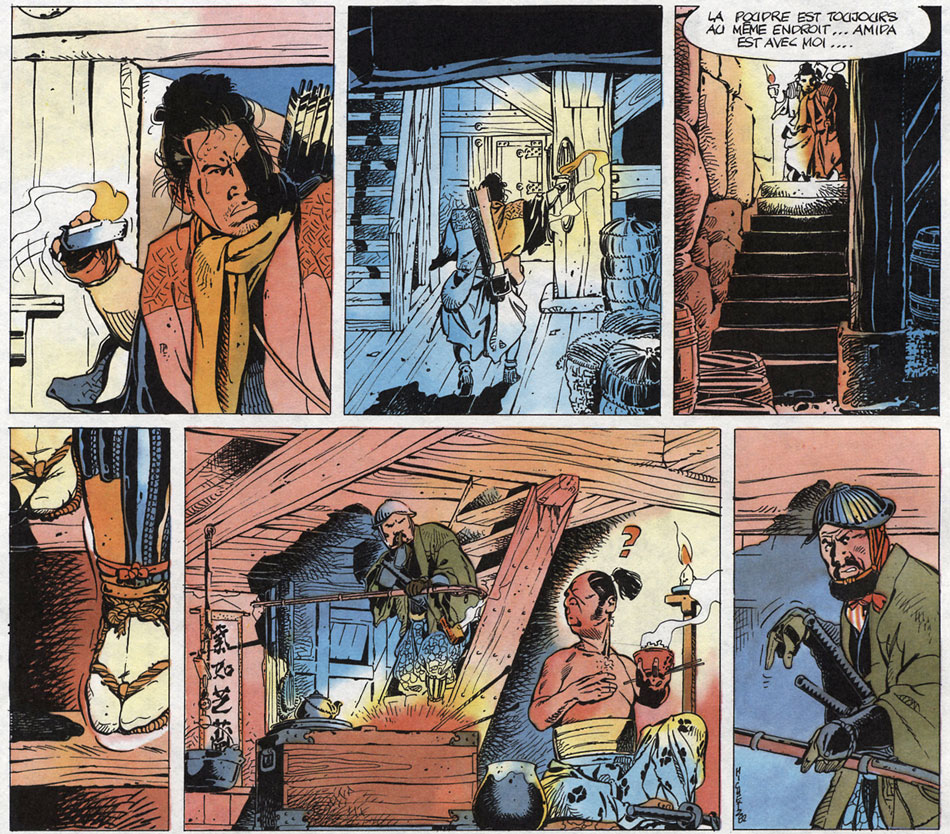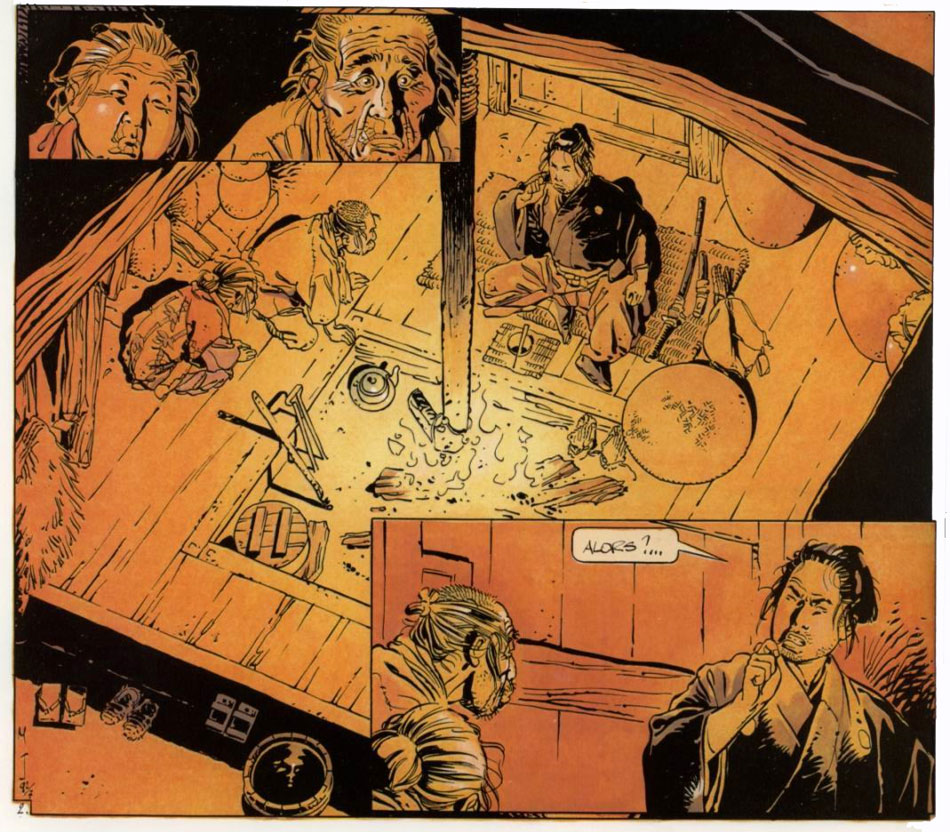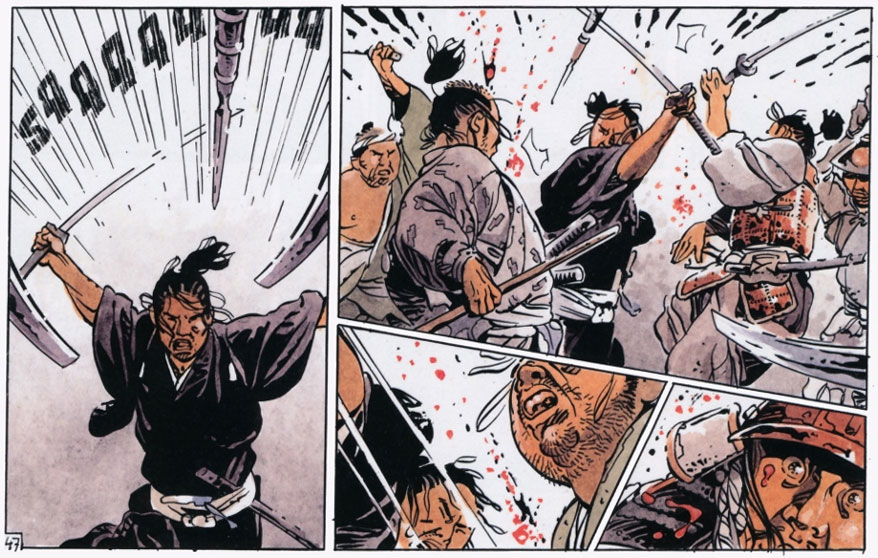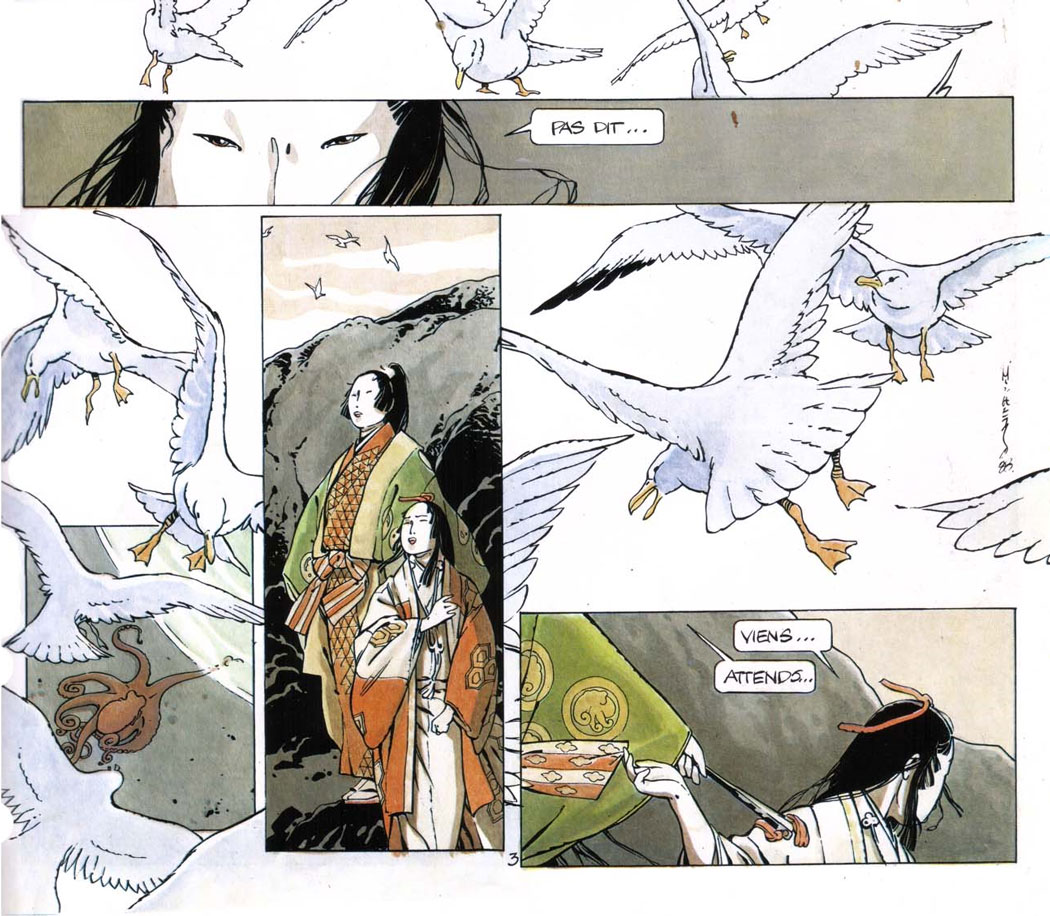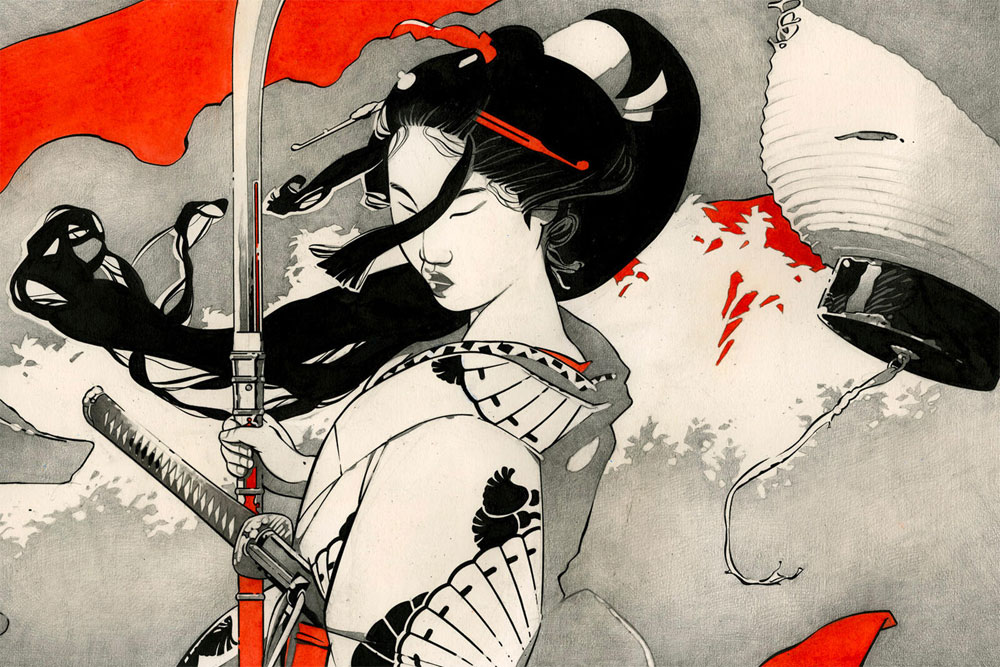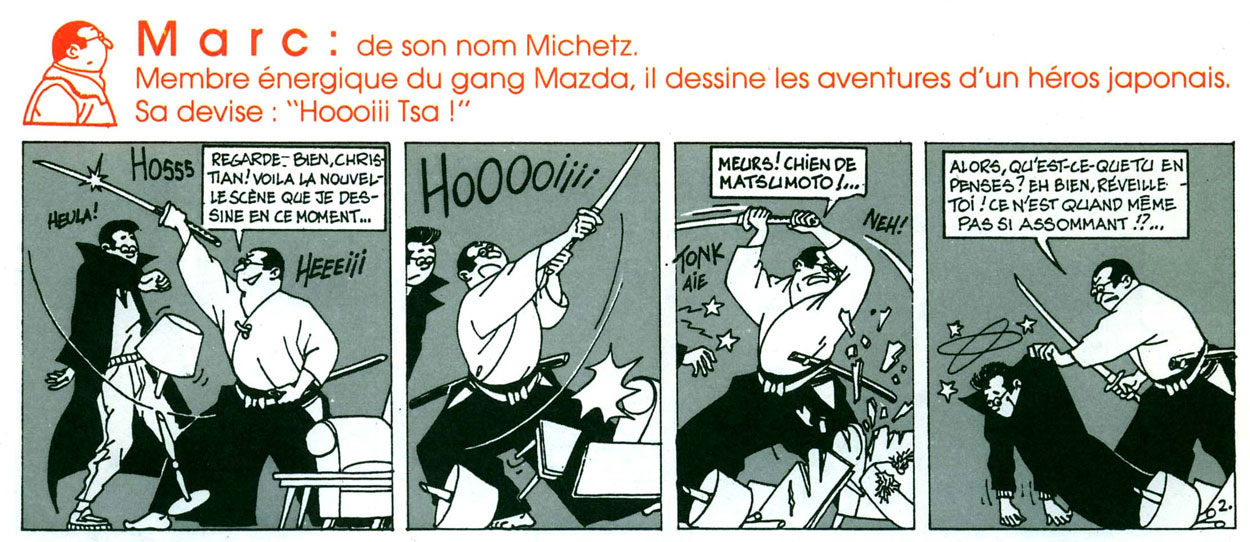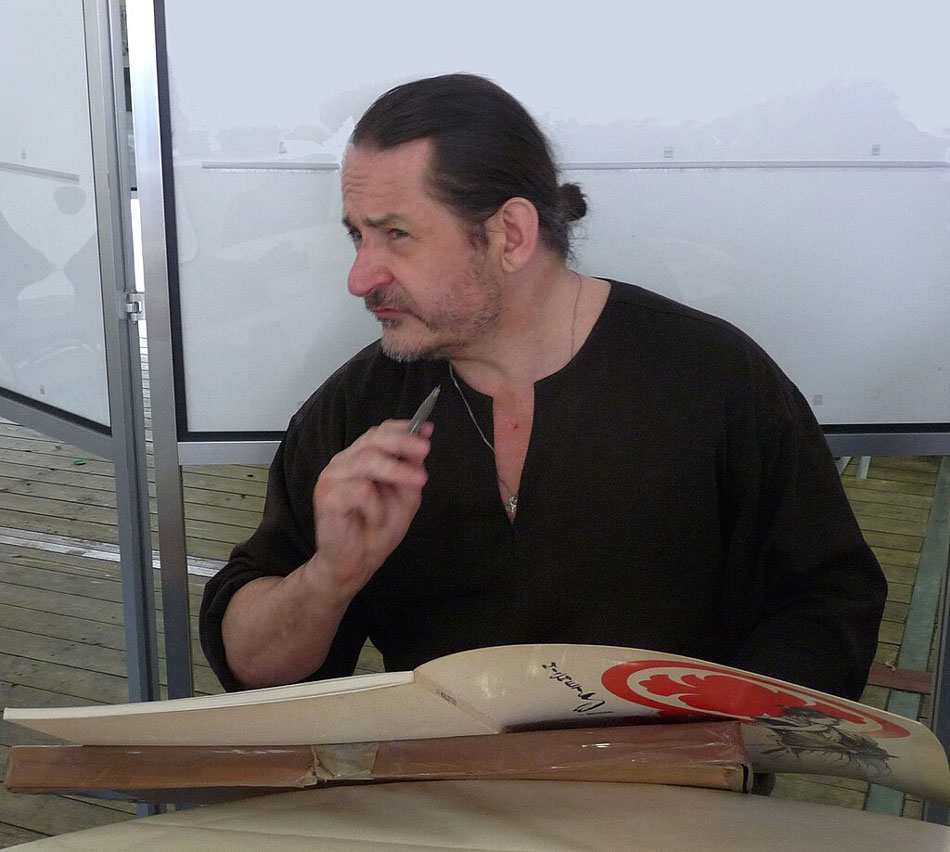Kogaratsu #9 - 'La Stratégie des Phalènes' (2000).
Marc Michetz was a Belgian comic artist with a strong affection for historical Japan and its traditions, martial arts and codes of honor. A meticulous worker and a perfectionist, his comic production fully embodied these preferences. Together with scriptwriter Bosse, he created his signature series 'Kogaratsu' (1983-2014), about wandering samurai and his spiritual journey. Among his other creations are the diptych 'Tako' (1990-1996) with scriptwriter Yann, and several illustration portfolios showcasing his interest in beautiful women and medieval Japan.
Early life
Michetz's real name was Marc Degroide, and he was born in 1951 in Ixelles, in the region of Brussels. He spent eighteen years living in Katanga, at the time one of the provinces of Belgian Congo. Back in Belgium, he worked in several professions, while also attending the Royal Academy of Fine Arts in Brussels. He developed a keen interest in Asian culture, and practiced martial arts like judo, kendo and finally iaido. While his early art still resembled the style of Franco-Belgian realistic artists such as Jean Giraud and Derib, his later comics revealed influences from Japanese Sumi-e ink wash paintings.
'Mutsuro' (Dutch-language version from Kuifje #4, 1979).
Early graphic career
Between 1975 and 1977, Marc Michetz began his career in comics at the studio of Jean Graton, creator of the racing comic 'Michel Vaillant' for Tintin magazine. In the 1975 episode 'San Francisco Circus', a caricature of Michetz was drawn by Graton in one of the panels. In Tintin issue #23 of 1977, Michetz - then still under his real name Degroide - drew his first solo comic, a "true story" of 4 pages about the rōnins in feudal Japan, written by Yves Duval. This story, titled 'Les 47 Rô-ninns', kicked off an ongoing theme and choice of subject matter for the artist's comics.
Two years later, he reappeared in Tintin's pages with 'Mutsuro' (Tintin #4, 1979), a short story about a samurai, written by Bermany. By then, the artist had begun using the pen name Michetz, chosen to express his preference for the Japanese civilization. Still in 1979, Michetz created the samurai serial ("Hito, the Outcast") for Spatial, a fantasy and sci-fi magazine published by Michel Deligne. During the early 1980s, he worked with the writer Bom on a script for a medieval series called 'Gauthier de Montrevel', for which Michetz made the pencil drawings and Christian Darasse did the inking. However, the series remained in the preliminary development phase and was never completed.
Kogaratsu #1 - 'Le Mon au Lotus de Sang' (1983).
Kogaratsu
In 1983, Marc Michetz joined Spirou magazine. Inspired by more adult-oriented magazines like À Suivre and Pilote, this Franco-Belgian children's magazine had by then opened its doors to more serious comics with either hardboiled action or philosophical undertones, for instance Philippe Berthet's 'Privé d'Hollywood' and Frank Le Gall's 'Théodore Poussin'. A combination of both was found in 'Kogaratsu', the new comic created by Marc Michetz with scriptwriter Bosse. Set in 17th century feudal Japan, the main hero Nakamura Kogaratsu is a young and loyal samurai in the service of his master Yimitsu. In secret, Yimitsu was raising the son of governor Yoshida, who was killed eleven years earlier by his brother Kishisi Mitsuru. During the first story cycle, Kogaratsu joins the rightful heir Kishiji Bando in his quest to overthrow his uncle Mitsuru.
Kogaratsu #5 - 'Par-delà les Cendres' (1994).
Along the way, the initially loyal and somewhat arrogant Kogaratsu loses faith in his master's methods and motives. Leaving Bando, he becomes a rōnin, a wandering samurai without a master. From then on, Kogaratsu travels through medieval Japan, helping those in need. While the early stories of the 'Kogaratsu' series were mainly event-driven, the later episodes had more room for reflection and character development. As the episodes progress, Kogaratsu becomes older and wiser, while his physical strength weakens. Strongly embracing influences from Japanese art and philosophy, Michetz and Bosse centered their later story about the spiritual journey of their hero. Characteristic in this development was the transformation of the artist's signature: in Japanese style, Michetz placed the letters vertically in Sōsho, the calligraphy in which the brush does not leave the paper while writing.
Kogaratsu #11 - 'Fournaise' (2008).
In 1985 and 1986, Spirou publisher Dupuis released the first two 'Kogaratsu' stories in its book collection 'Dupuis Aventures'. In 1988, the character received its own book series, which eventually ran for 14 volumes. Until 2002, the episodes were first serialized in Spirou magazine, the later installments were published directly in book format. Later in its run, the intervals between episodes became longer and longer, and the final book appeared in 2014. Translations of the 'Kogaratsu' books have appeared in Dutch, German and Spanish. In 1987, the UK publisher Acme Press released the first story in English under the title 'Kogaratsu: The Lotus of Blood', followed three years later by the U.S. publication of 'Kogaratsu: The Bloody Lotus' by Catalan Communications.
Tako
While 'Kogaratsu' remained the main focus of Marc Michetz, he additionally worked on a handful of other comics. Together with scriptwriter Yann, he created two volumes of 'Tako' (1990-1996) in the Charactère collection of the publisher Glénat. A fable close in theme to Shakespeare's 'King Lear', the series told the story of three brides in 16th century Japan who await the return of the samurai who have gone to war.
Graphic contributions
In 1986, Michetz participated in the collective album 'Pétition - À la Recherche d'Oesterheld et de tant d'autres!' by Amnesty International, dedicated to the comic writer Héctor Germán Oesterheld and other victims of the Argentine military junta. In 1998, he was one of the comic artists drawing a "naughty version" of a classic Perrault fairy tale in the second volume of the series 'Sales Petites Contes' (Dupuis Humour Libre, 1998).
Illustrator and designer
In addition to comics, Marc Michetz has produced much artwork for bookplates, portfolios, silkscreen prints, posters, cards and wine/beer labels, often showing his talent for depicting historical Japan and its beautiful women. In 1997, he provided the illustrations for 'Exorcisme, a story by Didier Robert published by Éditions Pyramides. His illustrations have regularly been on display at the Marc Breyne Gallery in Brussels.
Earlier in his career, Marc Michetz designed jewelry (1975-1983) and provided the graphic design for tinware figurines (1985-1986).
Character
Over the years, Marc Michetz turned into one of the most notable realistic Franco-Belgian comic artists of the generation. He was the first to accurately introduce European readers to historical Japan and its traditions, long before manga became popular in the continent. He also helped other artists with a similar interest in oriental art to have their work published, for instance the Belgian-Korean artist Jung Henin. Marc Michetz has also been named an influence by Rafael Morales. A meticulous worker with a penchant for thorough documentation, Michetz was a notorious perfectionist, explaining his limited body of work. In a rare December 2024 interview with ActuaBD, the artist revealed he was never fully satisfied with his work, saying: "I never show up at the openings of my exhibitions, because I personally find it indecent. I feel like I'm naked in front of people's gaze, which makes me uncomfortable. Moreover, I'm not at all proud of my work."
Introduction of the character Marc Michetz in the comic 'Le Gang Mazda' by Christian Darasse (1986).
A reclusive and secretive artist, Marc Michetz has hardly spoken in public about his art or work philosophies. The closest introduction to the man is through his comic book version in the gag series 'Le Gang Mazda'. In 1986, the three young comic creators Christian Darasse, Bernard Hislaire and Marc Michetz worked together in an atelier above an old Mazda garage in the Rue du Prince Royal in Brussels. For fun, Darasse and Hislaire captured their experiences in a series of gag comics, which eventually found their way to Spirou magazine. While the comic ran from 1987 to 1996, Marc Michetz actually worked in the studio for only a couple of months. The first years of the comic, when still written by Hislaire, is probably the most autobiographical. In the gags, the caricatured version of Michetz is presented as a grumpy but hard worker, who quickly loses his temper when he is disturbed or otherwise triggered. His colleagues on the other hand are a loafer (Darasse) and a romantic dreamer (Hislaire). Fully dedicated to his craft, the comic book Marc is shown as embracing Japanese lifestyles, for instance meditating or waving his samurai sword around.
Death
In late 2024, Marc Michetz produced new artwork for an exhibition at the Marc Breyne's gallery in Brussels. A couple of months later, the Franco-Belgian comic community was shocked to learn that the artist had died suddenly in Saint-Gilles on 7 January 2025. He was 73 years old.


